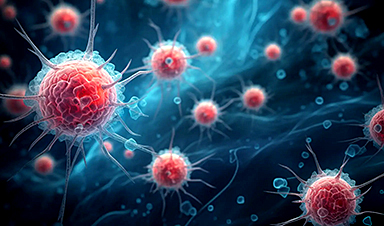An MD Anderson study provides a deeper understanding of the progression of gastric cancer and highlights a potential therapeutic target.
A recent study conducted by scientists at The University of Texas MD Anderson Cancer Center offers new insight into how the tumor microenvironment changes during the development of gastric cancer. Highlights of the study, published in Cancer Cell, include a connection between multicellular communities and patient outcomes, as well as a promising new target for therapy.
Gastric adenocarcinoma ranks among the deadliest cancers worldwide, primarily due to its natural resistance to treatment. However, the cellular and molecular processes that drive the transition from early pre-cancerous stages to tumor formation and metastasis remain largely unclear. This study illuminates the ways in which different immune and stromal cell subsets change throughout the progression of gastric cancer.

Linghua Wang, M.D., Ph.D. Credit: MD Anderson Cancer Center
The study was conducted by Linghua Wang, M.D., Ph.D., associate professor of Genomic Medicine, in collaboration with Jaffer Ajani, M.D., professor of Gastrointestinal Medical Oncology, and Ruiping Wang, Ph.D., postdoctoral fellow in the Wang Lab.
By obtaining single-cell RNA sequencing (scRNA-seq) data from 68 gastric adenocarcinoma samples encompassing various disease stages — including precancerous lesions, localized tumors, and distant metastases — along with normal tissue and peripheral blood samples, the team characterized the diverse immune and stromal cell populations within the tumor microenvironment and discovered exploitable targets to modulate the tumor microenvironment.
A novel approach allows researchers to dissect the complex tumor microenvironment
Various immune and stromal cell subsets formed multicellular communities, or collections of cell states, present in the tumor microenvironment of an individual tumor sample. The research team termed these groups "ecotypes" and identified six unique ecotypes, with each dominated by specific immune and stromal cell states.
"While many published single-cell studies have focused on characterizing the heterogeneity of each individual cell compartment, our study utilized a novel approach and concept of integrating various components of the tumor microenvironment to define ecotypes and investigated their clinical significance," Wang said. "This approach can readily be applied to studies in other cancer types."
A notable discovery is that two ecotypes (EC3 and EC6) correlated with different histological, genomic, and clinical features of primary gastric adenocarcinomas. Tumors categorized as EC3 were composed mainly of immune cell subsets, whereas EC6 tumors predominantly included stromal cell subsets. Patients with EC6 tumors had more aggressive disease and significantly shorter survival compared to those with EC3 tumors.
Findings point to SDC2 as a potential therapeutic target in stromal cells
While stromal components within the tumor microenvironment play crucial roles in tumor initiation, progression, and metastases, cancer treatment strategies have thus far rarely focused on modulating stromal components, especially in patients with gastric adenocarcinoma.
This study identified SDC2 as a potential target worthy of further investigation. Researchers found SDC2 overexpression in stromal cells, especially in cancer-associated fibroblasts, was correlated with aggressive disease and advanced stages, and strongly associated with unfavorable survival outcomes. In addition, SDC2 expression was consistently elevated in stromal cells across various other cancer types, including pancreatic cancer, colorectal cancer, bladder cancer, breast cancer, and clear cell renal cell carcinoma.
"There are unmet needs for patients with gastric adenocarcinoma every step of the way in their clinical journey," Ajani said. "Our team strives to use novel interrogations to discover new therapeutic targets to improve the outcomes of these patients. While there are many questions left to answer, targeting SDC2 in cancer-associated fibroblasts represents a potentially exciting avenue that warrants further investigation."
Reference: "Evolution of immune and stromal cell states and ecotypes during gastric adenocarcinoma progression" by Ruiping Wang, Shumei Song, Jiangjiang Qin, Katsuhiro Yoshimura, Fuduan Peng, Yanshuo Chu, Yuan Li, Yibo Fan, Jiankang Jin, Minghao Dang, Enyu Dai, Guangsheng Pei, Guangchun Han, Dapeng Hao, Yating Li, Deyali Chatterjee, Kazuto Harada, Melissa Pool Pizzi, Ailing W. Scott, Ghia Tatlonghari and Linghua Wang, 6 July 2023, Cancer Cell.
DOI: 10.1016/j.ccell.2023.06.005
News
Scientists Melt Cancer’s Hidden “Power Hubs” and Stop Tumor Growth
Researchers discovered that in a rare kidney cancer, RNA builds droplet-like hubs that act as growth control centers inside tumor cells. By engineering a molecular switch to dissolve these hubs, they were able to halt cancer [...]
Platelet-inspired nanoparticles could improve treatment of inflammatory diseases
Scientists have developed platelet-inspired nanoparticles that deliver anti-inflammatory drugs directly to brain-computer interface implants, doubling their effectiveness. Scientists have found a way to improve the performance of brain-computer interface (BCI) electrodes by delivering anti-inflammatory drugs directly [...]
After 150 years, a new chapter in cancer therapy is finally beginning
For decades, researchers have been looking for ways to destroy cancer cells in a targeted manner without further weakening the body. But for many patients whose immune system is severely impaired by chemotherapy or radiation, [...]
Older chemical libraries show promise for fighting resistant strains of COVID-19 virus
SARS‑CoV‑2, the virus that causes COVID-19, continues to mutate, with some newer strains becoming less responsive to current antiviral treatments like Paxlovid. Now, University of California San Diego scientists and an international team of [...]
Lower doses of immunotherapy for skin cancer give better results, study suggests
According to a new study, lower doses of approved immunotherapy for malignant melanoma can give better results against tumors, while reducing side effects. This is reported by researchers at Karolinska Institutet in the Journal of the National [...]
Researchers highlight five pathways through which microplastics can harm the brain
Microplastics could be fueling neurodegenerative diseases like Alzheimer's and Parkinson's, with a new study highlighting five ways microplastics can trigger inflammation and damage in the brain. More than 57 million people live with dementia, [...]
Tiny Metal Nanodots Obliterate Cancer Cells While Largely Sparing Healthy Tissue
Scientists have developed tiny metal-oxide particles that push cancer cells past their stress limits while sparing healthy tissue. An international team led by RMIT University has developed tiny particles called nanodots, crafted from a metallic compound, [...]
Gold Nanoclusters Could Supercharge Quantum Computers
Researchers found that gold “super atoms” can behave like the atoms in top-tier quantum systems—only far easier to scale. These tiny clusters can be customized at the molecular level, offering a powerful, tunable foundation [...]
A single shot of HPV vaccine may be enough to fight cervical cancer, study finds
WASHINGTON -- A single HPV vaccination appears just as effective as two doses at preventing the viral infection that causes cervical cancer, researchers reported Wednesday. HPV, or human papillomavirus, is very common and spread [...]
New technique overcomes technological barrier in 3D brain imaging
Scientists at the Swiss Light Source SLS have succeeded in mapping a piece of brain tissue in 3D at unprecedented resolution using X-rays, non-destructively. The breakthrough overcomes a long-standing technological barrier that had limited [...]
Scientists Uncover Hidden Blood Pattern in Long COVID
Researchers found persistent microclot and NET structures in Long COVID blood that may explain long-lasting symptoms. Researchers examining Long COVID have identified a structural connection between circulating microclots and neutrophil extracellular traps (NETs). The [...]
This Cellular Trick Helps Cancer Spread, but Could Also Stop It
Groups of normal cbiells can sense far into their surroundings, helping explain cancer cell migration. Understanding this ability could lead to new ways to limit tumor spread. The tale of the princess and the [...]
New mRNA therapy targets drug-resistant pneumonia
Bacteria that multiply on surfaces are a major headache in health care when they gain a foothold on, for example, implants or in catheters. Researchers at Chalmers University of Technology in Sweden have found [...]
Current Heart Health Guidelines Are Failing To Catch a Deadly Genetic Killer
New research reveals that standard screening misses most people with a common inherited cholesterol disorder. A Mayo Clinic study reports that current genetic screening guidelines overlook most people who have familial hypercholesterolemia, an inherited disorder that [...]
Scientists Identify the Evolutionary “Purpose” of Consciousness
Summary: Researchers at Ruhr University Bochum explore why consciousness evolved and why different species developed it in distinct ways. By comparing humans with birds, they show that complex awareness may arise through different neural architectures yet [...]
Novel mRNA therapy curbs antibiotic-resistant infections in preclinical lung models
Researchers at the Icahn School of Medicine at Mount Sinai and collaborators have reported early success with a novel mRNA-based therapy designed to combat antibiotic-resistant bacteria. The findings, published in Nature Biotechnology, show that in [...]





















